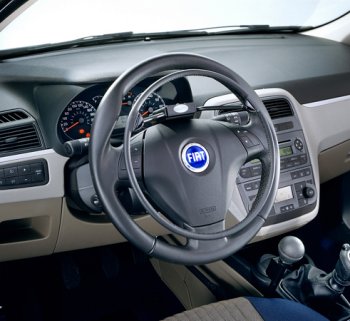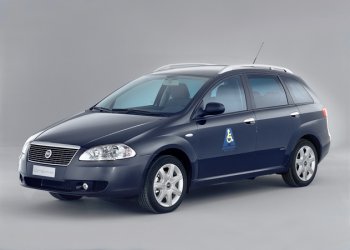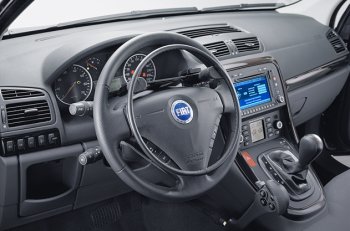|
Freedom of
movement is a fundamental civil right. And ensuring mobility
to all, regardless of physical or civil status, is a
towering achievement. Resources, infrastructures and laws
are not enough. Something extra is required: the entire
community must make an intuitive and cultural leap. With the
aim of focusing the attention of the crowds of youngsters
attracted to the Bologna Motor Show, the Fiat Group has set
up a stand extending for more than 200 m2 devoted to the
Autonomy Programme that completed ten years of consistent
commitment to this field in 2005.
Fiat has now been promoting this initiative since 1995 with
the aim of producing individual and collective services and
vehicles for people with reduced motor capacities and to
help disabled people become mobile. Fiat considers that
guaranteeing mobility to all is not simply a great moral and
civil aim, a goal the entire community must strive for, but
also a fundamental premise for economic and cultural
development in present-day society. We have long been
pouring our commitment and energy into achieving what we
feel to be the specific duty of any automotive manufacturer.
In other words, to design and produce technical solutions
that allow everyone the possibility of using a means of
transport - whether individual and collective - without
limitations of any kind.
This activity is in any case perfectly consistent with the
true vocation of an enterprise that by its very nature
operates on the market in accordance with strictly financial
considerations to meet human needs. In other words, to meet
the needs of all customers, of all customers: including the
disabled and the elderly. This was the thinking behind the
introduction of the Autonomy programme within Fiat Auto in
1995. This choice was not made by chance but based on the
consideration that the car is the most flexible way to
promote freedom of movement because it lacks the
architectural barriers that affect the use of collective
transport vehicles. Not to mention the fact that
technological progress has now made available a whole set of
auxiliary devices that are increasingly well-adapted to
supporting different types of motor impairment: from Dual
Drive gearboxes to parking sensors.
In the wake of these reflections and with the backing of
certain disabled associations and sector operators, a
specific department was set up within Fiat Auto. In other
words, an organisational unit responsible for developing and
marketing products and services destined for people with
handicaps. Services also received special attention, with
the setting up of Mobility Centres, external structures that
cooperate with public authorities to aid the issue of
special licences.
The Centres - currently 14 in Italy, 12 in the rest of
Europe and 3 in Brazil - perform aptitude tests and assess
psychomotor ability. They also advise on the most
appropriate technical solutions for each individual using
very advanced tools such as driving simulators. They must be
doing an excellent job because more than one thousand people
attend these centres each year in Europe. The results were
looking so encouraging by 2001 that Fiat was prompted to
extend the project to all three brands in the Group. From
that moment, Autonomy therefore became a commitment across
the board to connect and involve all Fiat companies that
directly or indirectly work within the people transport
field. With an eye to the future, the mobility project also
extends to technological research activities, particularly
in the field of ergonomics and safety systems.
These research activities will form an integral part of the
work of the product platforms that are responsible for
producing more legible on-board instruments, less tiring
driving systems, lowered floorpans and much more.
Innovations that are useful to the disabled and elderly - or
any customer for that matter. A good number of technical
applications designed for the disabled and elderly can be
transferred to 'standard' production with great advantages
to all users.
Adapted cars alone are not enough to ensure mobility. We
need to resolve the broad-ranging and complex question of
intermodal transport systems and break down the
architectural barriers that prevent the use of vehicles. The
industry cannot take sole responsibility for tackling this
question. The thing the industry can do is to prepare the
technical ground to ensure that we can transfer seamlessly
from the use of individual means of transport to the use of
an integrated vehicle system. And then declare our full
willingness to cooperate in studying, understanding and,
above all, playing a hands-on part in helping the many people who are
involved in this field by responsibility or by choice.
|

 |
|
Fiat Auto will be exhibiting just a few of its huge
selection of vehicles for the disabled
at the 30th Bologna Motor
Show |
|
|

 |
|
Fiat has now been promoting the Autonomy initiative
since 1995 with the aim of producing individual and
collective services and vehicles for people with
reduced motor capacities and to help many disabled
people become mobile |
|
|
The 'Turin 2006'
section on the stand features our preparations for the
future winter Olympics and also the Paralympics, a sporting
and human challenge that Fiat Autonomy has fully embraced
because it sends out a heartfelt message to all: everyone is
able, it is simply that our abilities are different - the
same abilities that spurred our Italian athletes to win so
many medals at the Athens Paralympic Games in 2004. Some of
these athletes will visit the Fiat Autonomy stand during the
Motor Show itself and will be able to see the latest
specially-outfitted Fiat Group models at first hand: Grande
Punto, Croma and New DoblÚ. The first represents the
youthful, sport side of mobility; the second represents
comfort and quintessential Italian class - and the third
stands for sturdy practicality.
Grande Punto,
Croma and New DoblÚ join the Autonomy programme
Fiat Auto will
be exhibiting just a few of its huge selection of vehicles
for the disabled at the 30th Bologna Motor Show. The
Autonomy programme is now an integral part of Fiat Auto's
policies: all new Fiat models are planned from the design
stage to ensure they are easily adaptable to special
assisted mobility equipment. This commitment has also been
backed by special know-how acquired in the field and
cooperation with the main body conversion specialists. Our
commitment is best exemplified by the cars on show in
Bologna. These stars of the Autonomy stand all offer great
roominess and outstanding access, plus a host of major
devices to ensure easy, convenient vehicle use. The Grande
Punto and Croma on show are equipped with a 1.3 Multijet
engine and a 1.9 Multijet engine with automatic transmission
respectively. These new models have aroused the interest of
the public and press since they were first launched and can
be seen here fitted with certain special devices. Namely an
electronic accelerator ring, a device that converts an
accelerator pedal into a steering wheel control and a
long-armed service brake that converts a pedal brake into a
manual control near the steering wheel. And more: an
electronic automatic clutch that allows gear changes without
depression of the clutch pedal at the barest touch of a
switch on the gear lever.
These vehicles, like all others in the Fiat, Alfa Romeo and
Lancia range, may be fitted with these and other special
devices (such as a sliding door, wheelchair loader and
swivelling seats) to facilitate driving for the disabled.
All these devices are easy to install and fit neatly into
the passenger compartment without impairing car
user-friendliness, passenger room, comfort and safety. They
can also be fitted alongside standard controls to enable the
car to be driven by people without motor difficulties as
well. They can also be easily removed with the advantage
that the car can be sold as a specially-equipped car or a
normal car.
The stand also includes a space for a New DoblÚ equipped
with a lively 1.4 16v engine and specially equipped for
carrying disabled people. The model on show features the
Dynamic specification with glazed high top and high rear
side-hinged doors that allow a wheelchair direct access to
the vehicle by virtue of the 25 centimetres of extra space
at the top. Rear access is made possible by a lift that
stows away within the floorpan so that the entire load
compartment can be exploited when it is not in use. The
laminated wood rear floor is covered with linoleum and
equipped with guides and hooks to anchor the wheelchair
during transport. The double rear bench (that replaces the
single seat) also enables the wheelchair to be arranged to
the right of the vehicle thus allowing more space and
visibility for the disabled person. The metal high top is
fitted with a generous smoked front window (to protect the
occupants from sunlight) and two long side windows that give
a good view outside. The height of the rear opening (1450
millimetres) and the maximum load compartment height (1550
millimetres) set the New DoblÚ at the top of its category in
terms of rear access and passenger room.
The Fiat Autonomy stand also allows visitors to have a close
look at a new system for loading wheelchairs by means of a
Vangater II lift. This device, designed to take up the
minimum amount of room on board, is lighter, more compact
and meets all safety standards. The folding, nonslip
platform is made out of steel and is controlled by a
wire-operated remote control at the press of a button. And
more: a new position sensor prevents possible accidents and
automatic barriers operate as the wheelchair is raised and
lowered to ensure maximum safety during operations. Lastly,
the new Vangater II lift is hydraulic and equipped with a
manual emergency operating device.
|
|
|
|
![]()
![]()